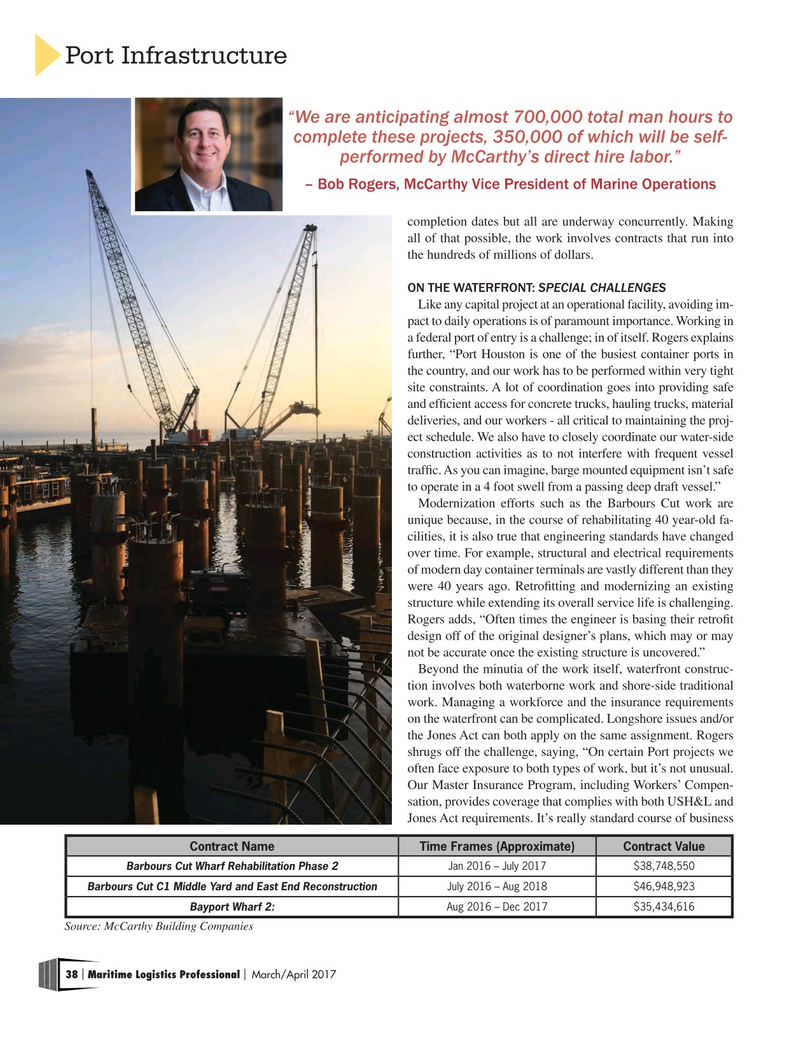
Page 38: of Maritime Logistics Professional Magazine (May/Jun 2017)
BUNKER OPERATIONS & PORTS
Read this page in Pdf, Flash or Html5 edition of May/Jun 2017 Maritime Logistics Professional Magazine
Port Infrastructure “We are anticipating almost 700,000 total man hours to complete these projects, 350,000 of which will be self- performed by McCarthy’s direct hire labor.” – Bob Rogers, McCarthy Vice President of Marine Operations completion dates but all are underway concurrently. Making all of that possible, the work involves contracts that run into the hundreds of millions of dollars.
ON THE WATERFRONT: SPECIAL CHALLENGES
Like any capital project at an operational facility, avoiding im- pact to daily operations is of paramount importance. Working in a federal port of entry is a challenge; in of itself. Rogers explains further, “Port Houston is one of the busiest container ports in the country, and our work has to be performed within very tight site constraints. A lot of coordination goes into providing safe and effcient access for concrete trucks, hauling trucks, material deliveries, and our workers - all critical to maintaining the proj- ect schedule. We also have to closely coordinate our water-side construction activities as to not interfere with frequent vessel traffc. As you can imagine, barge mounted equipment isn’t safe to operate in a 4 foot swell from a passing deep draft vessel.”
Modernization efforts such as the Barbours Cut work are unique because, in the course of rehabilitating 40 year-old fa- cilities, it is also true that engineering standards have changed over time. For example, structural and electrical requirements of modern day container terminals are vastly different than they were 40 years ago. Retroftting and modernizing an existing structure while extending its overall service life is challenging.
Rogers adds, “Often times the engineer is basing their retroft design off of the original designer’s plans, which may or may not be accurate once the existing structure is uncovered.”
Beyond the minutia of the work itself, waterfront construc- tion involves both waterborne work and shore-side traditional work. Managing a workforce and the insurance requirements on the waterfront can be complicated. Longshore issues and/or the Jones Act can both apply on the same assignment. Rogers shrugs off the challenge, saying, “On certain Port projects we often face exposure to both types of work, but it’s not unusual.
Our Master Insurance Program, including Workers’ Compen- sation, provides coverage that complies with both USH&L and
Jones Act requirements. It’s really standard course of business
Contract Name Time Frames (Approximate) Contract Value
Barbours Cut Wharf Rehabilitation Phase 2 Jan 2016 – July 2017 $38,748,550
Barbours Cut C1 Middle Yard and East End Reconstruction July 2016 – Aug 2018 $46,948,923
Bayport Wharf 2: Aug 2016 – Dec 2017 $35,434,616
Source: McCarthy Building Companies 38 Maritime Logistics Professional March/April 2017 | |

 37
37

 39
39
